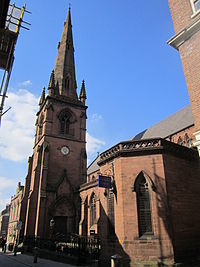Guildhall, Chester
| Guildhall, Chester | |
|---|---|

Guildhall from Watergate Street
|
|
| Coordinates: 53°11′24″N 2°53′41″W / 53.1899°N 2.8946°W | |
| OS grid reference | SJ 403 663 |
| Location | Watergate Street, Chester, Cheshire |
| Country | England |
| Denomination | Anglican |
| History | |
| Former name(s) | Holy Trinity Church, Chester |
| Architecture | |
| Functional status | Redundant |
| Heritage designation | Grade II |
| Designated | 28 July 1955 |
| Architect(s) | James Harrison |
| Architectural type | Church |
| Style | Gothic Revival |
| Completed | 1869 |
| Specifications | |
| Materials | Red sandstone with slate roofs |
The Guildhall, formerly Holy Trinity Church, is a redundant church in Watergate in the city of Chester, Cheshire, England. It is recorded in the National Heritage List for England as a designated Grade II listed building. The church closed in 1960, became known as the Guildhall, and was converted to be used for secular purposes.
The original building, which had a north aisle, probably dated from the 14th century. The east end and south side were rebuilt in 1680. This church had a spire which was rebuilt in the 1770s but in 1811 was taken down for reasons of safety. The present church was built between 1865 and 1869 to a design by James Harrison. He died before it was finished and the church was completed by the firm of Kelly and Edwards of Chester.
It is built in red sandstone with grey slate roofs. Its plan consists of a continuous nave and chancel with a clerestory, a west porch, a detached south spire and porch, and a vestry to the south. The tower has three stages with double doors to the east and above this a relief sculpture of Christ enthroned. The second stage has a lancet window and clock faces to the east and south. The third stage has two-light bell-openings, corner buttresses, a pierced parapet and a recessed octagonal stone spire with three lucarnes to each face.
Most of the fittings have been removed. The east window, dated 1885, is by Kempe, and depicts God and major Old Testament figures and saints. Now hidden by flooring is a memorial to John Whitmore who died in 1374. The former chancel screen and the reredos are also hidden.
...
Wikipedia

